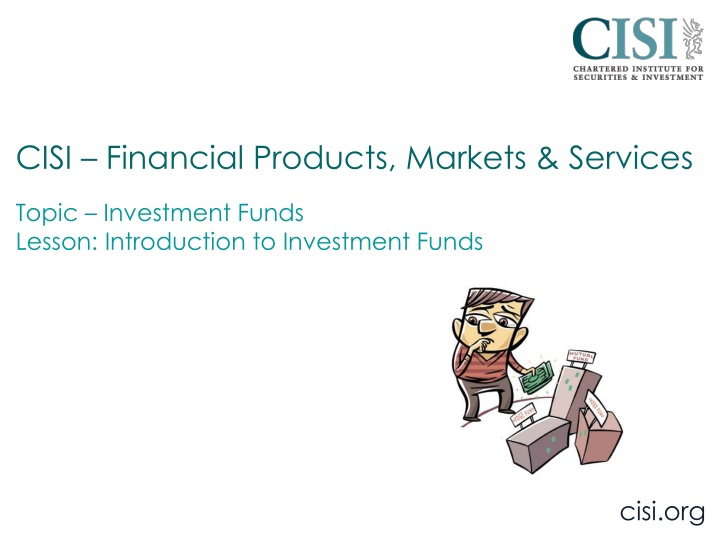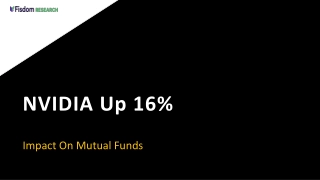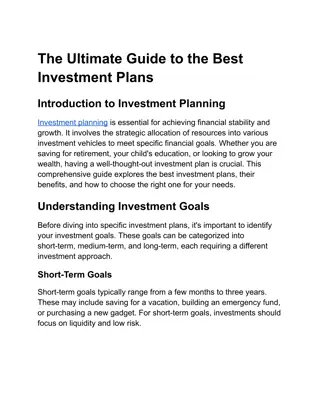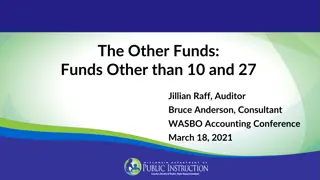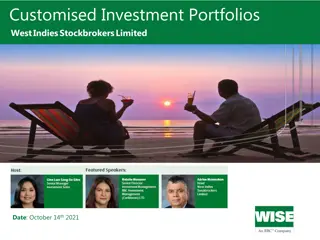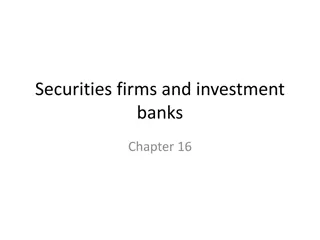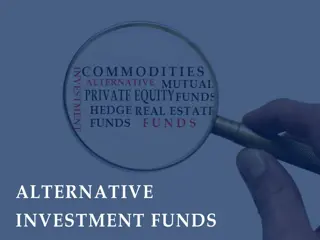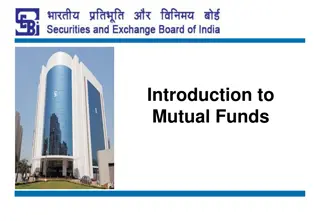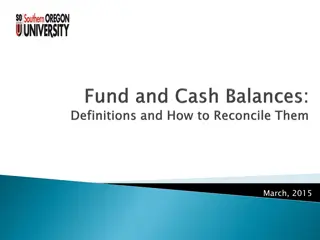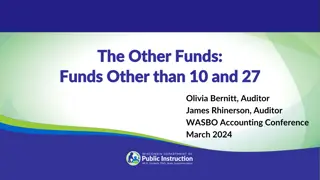Investment Funds: Types, Benefits, and Management
Investment funds offer a way for clients to invest money to meet specific objectives, managed by professionals who select suitable investments based on fund goals. Funds pool money from multiple investors for economies of scale, diversification, and access to professional management. Collective investment schemes provide tax efficiency and regulatory oversight. Various investment styles cater to different investor preferences and risk profiles.
Download Presentation

Please find below an Image/Link to download the presentation.
The content on the website is provided AS IS for your information and personal use only. It may not be sold, licensed, or shared on other websites without obtaining consent from the author.If you encounter any issues during the download, it is possible that the publisher has removed the file from their server.
You are allowed to download the files provided on this website for personal or commercial use, subject to the condition that they are used lawfully. All files are the property of their respective owners.
The content on the website is provided AS IS for your information and personal use only. It may not be sold, licensed, or shared on other websites without obtaining consent from the author.
E N D
Presentation Transcript
CISI Financial Products, Markets & Services Topic Investment Funds Lesson: Introduction to Investment Funds cisi.org
What are investment funds? Clients Want to invest money to meet particular objectives Investment Managers Also referred to as: asset management or fund management Select the most appropriate investments (mainly shares, bonds and money market instruments) for their clients based on the objective of an individual fund Funds pool the money together of many investors Also referred to as: Collective investment funds or Collective investment schemes or Mutual funds Are created by investment managers in which their clients can choose to invest. Each fund includes a collection of investors cisi.org
Buy and Sell side the importance of investment management in financial services Sell Side Buy Side Banks/Insurance sales Investment Managers Private investors and individuals Exchanges Corporates (Equity/Debt) Securities Houses Advisers Consultants Investment Banks Insurance funds Pension funds/Local authorities/ Charities The owners or managers of money that are paying for the sell side services with fees or commission. Selling of investment ideas, strategies, advice and services to either those with money to invest, or more likely those managing the investments on behalf of others Individuals investing their money, however much of this investment is done indirectly cisi.org
Benefits of Collective Investment Larger orders attract: More competitive dealing fees and commissions More attention from brokers and investment bankers - investment information can be more timely and comprehensive Economies of Scale A diversified portfolio contains a substantial number of investments and will be less risky than a portfolio with just one or two investments in it. Don t put all your eggs in one basket ! Diversification Professional investment management Give investors access to professional investment management and geographical areas or asset classes with which they may be unfamiliar Many funds are carefully vetted by financial services regulators before they can be marketed to potential investors. Regulatory Oversight Collective investment schemes pool the resources of a large number of investors, with the aim of pursuing a common investment objective. Investing in funds can be tax efficient. Many funds do not pay any tax on the income and gains they generate, and the investor only pays tax when she sells the investment. This is known as tax deferral Tax deferral cisi.org
Investment Styles There are lots of different types of investment funds. Styles Objectives Each fund will be managed according to the style adopted by the Fund Manager to meet the objectives of the fund. Style refers to the approach taken to choosing the investments for the fund. Each fund will have its own set of objectives and it will be made clear the types of financial assets they will invest in. e.g. To invest in the shares of UK companies with above- average potential for capital growth. Investment styles can be: Active or Passive cisi.org
Active Management Top-down approach Manager focuses on economic and industry trends rather than the prospects of particular companies e.g. Focus on growing economies such as China Aims to out-perform a predetermined benchmark over a specific time period e.g. Do better than the FTSE100 Active Fund Manager uses fundamental (forecasting events and the likely impact on a company) and technical analysis (Analysing share price trends) Management Bottom-up approach Analysis of a company s financial statements, strategy and management as a priority. e.g. Analysing a company s net assets, future profitability and cash flow Momentum Investing Picking shares where the price is rising on the assumption it will continue. Contrarian Investing Picking out of favour shares that may have value the rest of the market may not have spotted. Growth Investing Picking shares of companies most likely to grow in medium and long term Value Investing Picking the shares of companies that are cheap (under- valued) to their profits or cash-flow cisi.org
Passive Management Few active fund managers actually outperform their benchmarks, with many doing worse. Lower dealing costs ratio of staff to funds managed is lower than actively managed portfolios as well as the turnover of assets in the portfolio of investments being lower Aim to perform in line with or track the benchmark index. Often described as Index-tracker funds or Indexation. It simply buys the index constituents which means that the performance of the portfolio is designed to track the up- and-down movements of the index. Passive Management Performance is impacted by the need to rebalance the portfolio to replicate changes in the index constituent weightings and to adjust for stocks being promoted into and being relegated from the index. A passively managed Index-based portfolio will clearly follow the index down in bear markets. cisi.org
Core-Satellite Management Active Passive Management Management Core-satellite management Satellite Core Is the name given to the remainder of the portfolio which is invested in specialist actively managed funds or individual securities is the name given to around 70-80% of the fund s portfolio which is invested in index tracking funds to minimise risk of underperformance cisi.org
Range of Funds There are almost 2,500 UK domiciled authorised investment funds available to investors There needs to be a way to classify them so that investors can compare funds with similar objectives. Trade body, the Investment Association (IA) maintains a classification system, as does the Association of Investment Companies (AIC). The IA classifies investment funds between over 30 sectors. Within these, funds are categorised as: Providing Income or Providing growth or Specialised funds if they fall outside the previous two Each of the sectors contains funds investing in similar asset categories in the same stock market or same geographical area e.g. UK gilts or UK Corporate Bonds cisi.org
Range of Funds A useful example of how the IA sectors work can be seen by looking at bond funds and how the content of each differs: cisi.org
Authorised vs. Unauthorised Funds The authorisation of an investment fund has nothing to do with it being illegal or illegal to buy into it or use it but is related to who the fund can be marketed to. Authorisation is granted by the regulator The FCA Authorised Funds Unauthorised Funds They are sufficiently diversified and invest in a permitted range of assets Perfectly legal They can only be marketed to certain types of investor e.g. investment professionals or sophisticated investors. They can be freely marketed to the general public in the UK Unauthorised schemes are referred to as unauthorised collective investment schemes (UCIS). cisi.org
